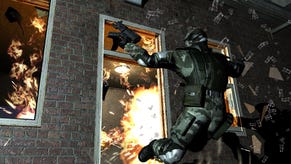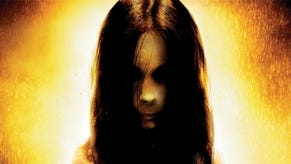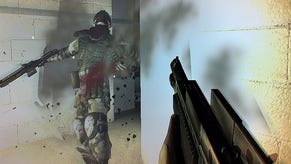F.E.A.R Single-Player
It stands for First Encounter Assault and Recon. We mention that now because it's not one of the factors that contribute to this being the most promising PC FPS of 2005...
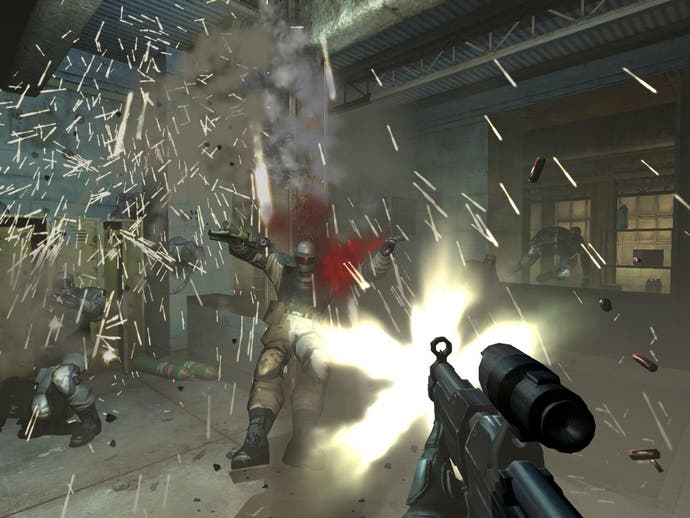
You are a man. (Apologies if you're not.) You are holding a big gun. You run into a room. People are standing around. Some more race in through doors nearby. They try to shoot you. They're a bit crap at it. You try to shoot them. So are you. Since you can use the health items you picked up earlier, you eventually overhaul them and they flop to the floor, dead. You loot their corpses, then set about finding the way to the next room.
This is what first-person shooters are generally like. It's what F.E.A.R is generally like. Rooms aren't always rooms - they can be corridors, or balconies, or whatever else you can imagine - but there's usually shooting. Perhaps with a few hand grenades literally thrown in for good measure.
You're probably wondering how, having lured you in with suspicions of F.E.A.R being one of the brightest FPS prospects due out in 2005, we came to decide that that was a good way of introducing it to you. The higher-ups at Vivendi-Universal Games, whose tirelessly cheery reps transported a gaggle of boggled British journos to Paris this week to witness the game first-hand and who will want to establish whether they got their money's worth, are probably wondering the same thing.
But, you see, we don't want to mislead you. On a fundamental level F.E.A.R is little more than a generic first-person shooter. There's no gravity gun to pick up the goalposts and shift them further down the field. Some of its basic ideas are more contemporary than others, but they are still ideas we've seen before - would we be using first-person melee roundhouse kicks and sweeps if games like Riddick hadn't already proved how well they can work? Even adding that it features a slow motion Bullet Time button is unlikely to stir you too much - particularly if we then note that Monolith reps were unable to really justify its inclusion at all to us when we asked, arguing somewhat confusedly that it was both loosely threaded into the story and a Max Payne-style "it's there because it's there" mechanic and encouraging us to make our own minds up.

And yet F.E.A.R is deserving of some quotable hyperbole. With the exception of Half-Life 2, it's "The most interesting FPS we've seen in the last two years." And it's not to do with miraculous innovation; it's to do with a refreshing blend of ideas and a strict mandate to leave you wanting more (we spent most of the second half of Half-Life 2 crying over our missing Antlions, you know). And on that most fundamental mechanical level it's to do with something that Monolith thinks is so crucial to your understanding of it that director of technology Kevin Stephens used the words "core concept" about 25 times in 25 minutes when we interviewed him; it's to do with the fact that it's been designed as an action movie. It's been designed not only for you to kill things, and wonder, but to make you look and feel very, very cool when you do it.
It's all about the layering. Let's stick with Max Payne, since that calls to mind a fitting example of what F.E.A.R gives us that we want so much. Having finished Max Payne several times in a few days, yours truly got into the habit of piling up Winamp with rock and metal (Rage Against The Machine was a regular) and then diving into a chapter midway through (that one where you clear out the hotel with the dodgy camera set-up, culminating in a gunfight in a bar, is a good example) and spending hours and hours simply leaping into rooms in slow motion and watching bullets crawl through the air on an inexorable path towards legions of nutters as Bullet Time followed their brain's natural impulses to expand every last one of their few seconds of remaining life into hours of last-minute reflection and reaction. We lost interest in doing that around about the time we'd seen everyone die in every way, and charting the path of bullets, ejecting brass and Max's flowing trenchcoat lost its charm - and our imaginations had nothing left to graft onto the experience.
With F.E.A.R, it's hard to imagine ourselves losing that desirable sense of cinematic intensity and the adrenaline it pumps before we've unravelled the mystery behind the game and killed everyone at least four or five times. It is just that spellbinding a spectacle to participate in. Let's revisit that opening scenario, shall we, and look a bit closer.

You are a man. You are holding a big gun. It's a big shotgun, actually. You run into a room. It's a sort of lobby area. People are standing around on a reflective marble floor. You can see a conference room on the other side of the lobby through glass panels that warp your view like some sort of mass of square-bottomed milk bottles pushed together. The people try to shoot you. You try to shoot them. All of a sudden the room is choked with billowing smoke, little clouds of blood-mist escaping through punctured Kevlar, bullets visibly embedding themselves in everything, shattering and sheering ceramic tiling from the pillars around you as they fly in at acute angles, while your focus is almost split by the sight of everything reflected in the marble floor as your shadows dance over the top.
A few too many bullets find their homes in the arms and legs of your adversaries, who sway and stumble about with each impact and eventually fall over bits of the scenery and lie there gushing blood. But there's no time to think because all of a sudden more people come rushing through the door at the back of the conference room. You can see their misshapen forms as they flow like rivers of dark light along the convex estuaries of the thick obscuring glass wall between you, before all of another sudden they start firing through the glass. You hit the slow motion button you'd almost forgotten about and watch their bullets carve smoke-tailed paths through the air between you, sending specs, chunks and even whole panes of glass tumbling away from the frame as the bad guys themselves lurch forward after their bullets and send hanging blinds flapping back and forward to burst through into the lobby. You fire some more shells, hit empty and leap forward kicking at the air like Neo in his lobby and watching them topple under your boots.
Still in slow-mo, the misty blood-clouds and flying-everything starting to engulf your senses completely, you toss a grenade and watch as your enemies fail to scatter in time - their cries of fear and anguish warped into unrecognisable sprawling low-pitched verses by the slow-down - and gasp as the slow-motion explosion seems to momentarily suck in the environment around it before a translucent wave of pain erupts forth in every direction and lashes your enemies against pillars, over chairs and back through the flapping blinds onto a bed of glass - where, were the level designers being really cheeky, you might have seen the effect, witnessed elsewhere, of unbalanced overhead projectors sweeping their faces with bright light and projected bullet points to complement the bullet holes, the light perfectly mapped to the contours of their body.
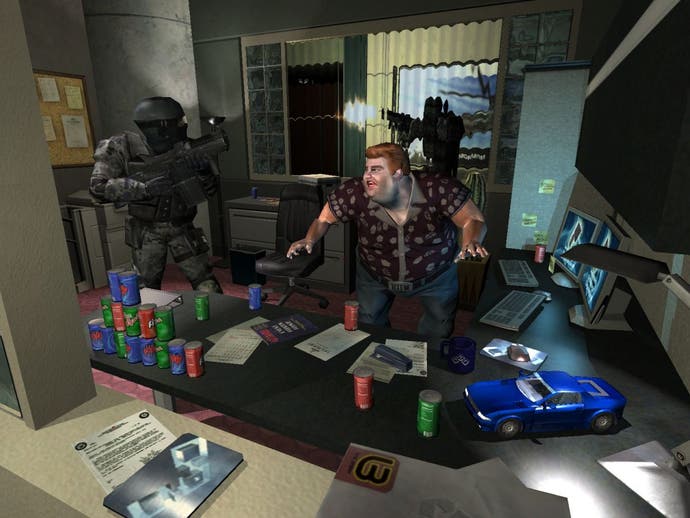
Everyone's dead. And you feel like you're in a action movie. And your head is swimming. And more than anything you want to rewind and do the exact same thing again, because there's little chance that you managed to take it all in the first time around, and there's even less hope that you'll ever experience the exact same gunfight twice.
The only word for what F.E.A.R does is carnage. The art of the special effects, flying particles, bouncing light and other sights and sounds is utterly intoxicating, and throughout all the worlds of realistically flighted falling boxes, alien landscapes and big explosions that we've explored in our time, including Max Payne's vision of dystopian New York, we've never felt as enamoured with a simple gunfight as we have done playing this game. Monolith talks about how content creation is a hugely time-consuming factor at this level, compared to the tail end of the last technology cycle; it's time well spent.
The difference is in the details, then. But is the devil?
No. Not on the evidence we've seen. We caught a glimpse of a pointy red tail in some of the clichés that underwrite the experience - the elite assault team being choppered in, each with different supernatural or heightened abilities (like a sniper with enhanced hearing); an installation overrun by some unknown force that literally rips a Delta Force response team to shreds after disrupting their communications; the team-leading Chicago drawl on the radio running commentary - but even these are executed with panache.
The reason being that they're all plot devices fuelling F.E.A.R's Japanese horror-inspired narrative, which despite its Eastern influences manages to harness the abovementioned hackneyed ideas to help guide you through the mysterious and inexplicable story of what's going on at the base - the delivery of which is typified by understatement and feasting on scraps of the unexplained.
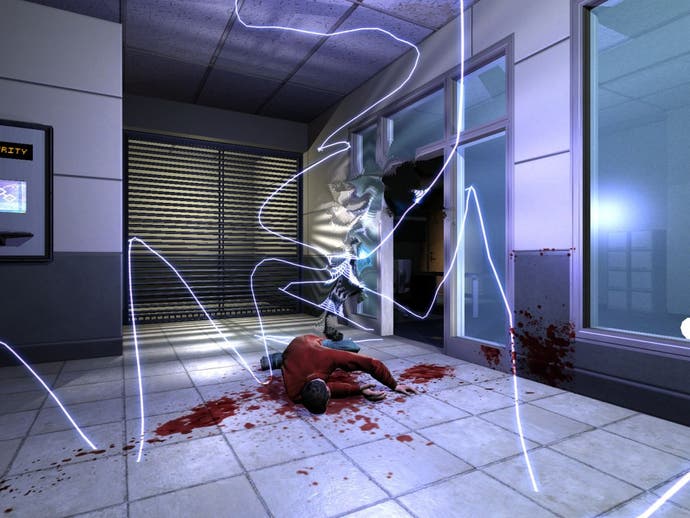
Monolith's Kevin Stephens nailed it when he tried to explain the storytelling approach to us on Tuesday. Although he left it to his lead designer to truly deconstruct the lure of Japanese (and Korean) horror compared to western directness and apply them in code form - of which there are promising signs in the various set-pieces we've seen - his observations that ghosts are more worrying than monsters and that it's not what you see but what you glimpse are well founded, and grounding the tale in a western setting and western clichés rather than eastern culture and setting gives it the same sort of narrative appeal as something like Resident Evil. Or Alien.
You find a sliced soldier in a lift and you're all gung ho about getting whatever did it. So you hop in and head on down, only for your HUD and torch to start flickering. Something's about to happen. Then a little girl appears right in your sights, and then blinks away with the next flicker. Not quite the monster you expected.
Then the following sequence, despite its obviously cheesy dialogue, manages to result in the same moment of exquisite panic every single time anyone plays through it.
You creep into a room. Your eyes are immediately drawn to the blood. It's everywhere. As you crane your head to look up at the ceiling a well-judged pang erupts through the speakers to mark your realisation that it's caked with the stuff. "Jesus," your team leader blurts over the radio as he sees what you're seeing. He tells you one of your fellow elites will join you shortly, and as another lift door opens and your compatriot follows the barrel of his assault rifle into the room, you feel like turning round to him and giving him those WTF eyes. But he's obviously hard. "You must be the new guy. I hear you're a bad mother f*****. I hope it's true."
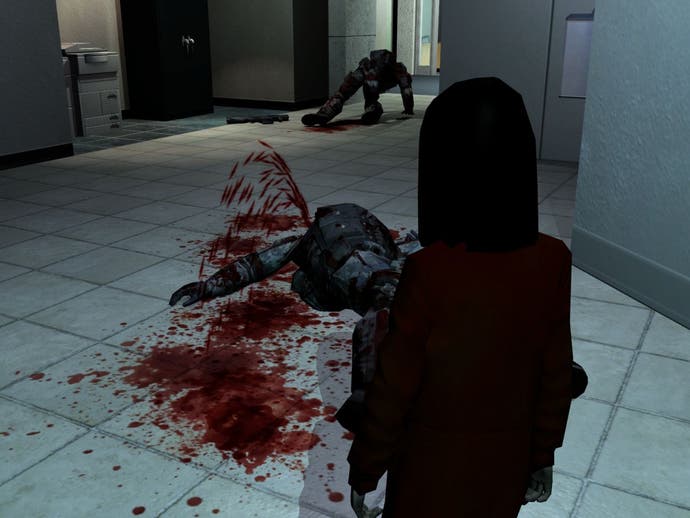
There's a moment of bleak but wary humour as he's asked what he thinks, and responds something like: "I think some bad s*** happened here." "No s***. Anything else?" As their darkly amusing exchange draws to an end with "Hey man, get off my d***, you asked what I thought!" it suddenly dovetails into a moment of tension. "Notice how there's no bullet holes? No brass? These guys never fired a shot." And yet they're all over the place. In pieces.
Thunk. Thunk. Thunk. As you near the far end of the room, the lights are thunking on. And off. And on. And off through a doorway shielded with shopfront-style shutters. "Something's coming." Suddenly the next thunk of light is punctuated by another taut pang of audio and the sight of a waist-high silhouette rushing arms-flailing towards the shutters from the other side. The sense of panic and the rounds of ammunition you react by wasting on this ghostly shape before it disappears with the next thunk are a testament to the sense of atmosphere and the sense of immersion. Clichés or not, you can't help but fall under F.E.A.R's spell.
Then the door opens. You have to go and investigate.
From what we've seen, F.E.A.R is going to be an experience that sticks to these ideas. When you fight, you fight clever enemies who communicate your position to one another, cover one another, and try to flank you - without ever being so clever that they overwhelm you as they might in reality with their numerical superiority - and the spectacle of taking them down is steeped in a peerless level of incidental detail, the intensity of it all accentuated by the moments of slow-motion and the first-person view itself, which adds another layer of involvement - something of a theme, as Monolith wants you to put yourself in the speechless, nameless role of the central protagonist much as Valve did with Half-Life 1 and 2. But the visually and mechanically arresting combat is an experience matched by the draw of the narrative and storytelling, which, in our admittedly brief encounter with the start of the single-player game, demonstrated a maturity and intelligence of style that gives us real hope for the final release. If you want a high-concept assessment, it could be Jerry Bruckheimer producing a collaborative effort from Hideo Nakata and Takashi Miike...
But you probably don't want high-concept. You'd be better off knowing that it left us wanting more. And if the whole game does that, as it seems designed to, Monolith will go some way to closing the gap between the words love and F.E.A.R in a lot of people's gushing write-ups.
So, in the end, the reason we began the way we did ought to be obvious: the beginning of F.E.A.R itself was sufficiently convincing all by itself. Vivendi higher-ups: you may just get your money's worth with this one.
Check back soon for more on F.E.A.R, including impressions of the multiplayer mode and a chat with Monolith director of technology Kevin Stephens.


